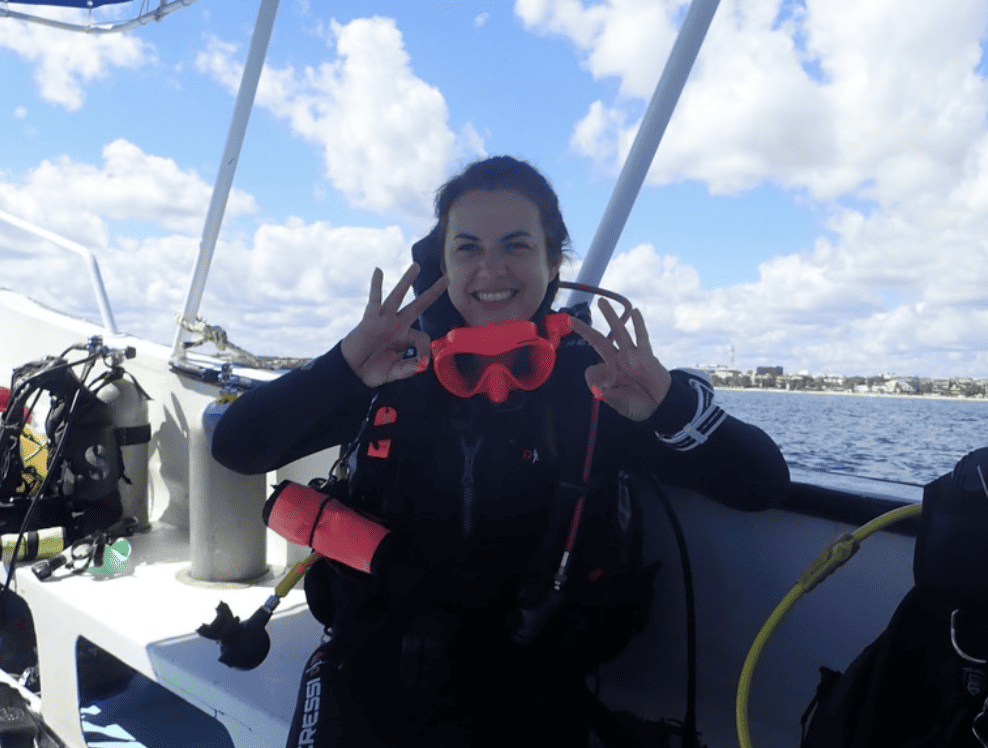As scuba divers, we’ve all heard that old joke: “Why do scuba divers fall backwards off the boat? Because otherwise, they’d still be in the boat…”
It’s a definite dad joke for sure, but it got us thinking… Do people know why?
Why actually do scuba divers fall backwards into the water?
If you’re wondering too, let this blog be your guide to all you need to know about the backward roll entry method for scuba diving.
We’ll also look at some other safe ways of getting into the water from the dive boat.
What is the Backward Roll?
The backward roll in scuba diving is a technique where divers enter the water by falling back from the side of a low boat. There is no need to intentionally flip into the water with force, just lean backward and let gravity do its thing!
Why Do Divers Use the Backward Roll?
Divers opt for the backward roll entry due for several reasons.
Protects Equipment
If a diver were to enter the water headfirst or forward, there’s a higher risk of impact that could potentially knock loose gauges, regulators, or other essential gear. This could lead to equipment malfunctions or even loss of some equipment.
The backward roll allows divers to keep a hand on their gear for control and prevent it from slipping off or getting tangled.
Avoids Injuries
Secondly, the backward roll entry is better for your body. When you dive you have a large heavy tank on your back, and if you hit the water face or head or front first – you’re going to hurt yourself with the extra weight of the gear. A back-roll entry means that the tank itself is what breaks the water surface, allowing you to plop into your dive location safely.
Minimizes Rocking
Jumping off can cause a small boat to rock, potentially putting other divers or crew off balance or causing equipment to fall. The backward roll enters the water more smoothly, minimizing this movement.
Efficient Entry
It’s a quick and efficient way to enter the water, especially when multiple divers are entering the water from a small boat at the same time.
Keeps Space Between You and the Boat
A backroll entry minimizes the risk of potential collisions with gear or the boat itself. When executing a backward roll, divers naturally move away from the boat, reducing the chances of accidentally bashing your body or equipment on the hull of the boat.
Good for a Small Space
The backward roll doesn’t require a lot of room on the dive boat, making it well-suited for small boats where space may be limited.

How to Perfect Your Backward Roll Entry
So, you’re ready to nail that backward roll entry like a pro?
Let’s dive right in with these simple steps:
- Before climbing onto the edge of the boat, make sure you’ve suited up with all your gear and completed your buddy check. Safety first!
- Sit yourself on the ledge of the boat, facing inwards. Hold on to the railings and await instruction from the boat captain and the rest of your dive team.
- Cross those ankles! It might sound like a yoga move, but trust us, it helps keep your legs together when you make your entrance into the water.
- Time for a quick equipment once-over. Ensure all your gauges and hoses are snugly secured, especially around the chest area. Bite onto that regulator and give your BCD a little half-inflate to keep things positively buoyant.
- Use the palm of your right hand to ensure your regulator is snugly in place and use your fingertips to keep your dive mask in place. The last thing you want is to lose a mask before you’ve begun!
- With your left hand, hold the mask strap at the back of your head.
- Before entry, you always need to look behind you. Ensure the coast is clear of any natural hazards or fellow divers. Often the boat captain will help you look.
- When the captain gives the signal or you’re feeling ready, it’s time to go! Count down with your buddy from 3, 2, 1… and go. Be sure to tuck that chin to your chest to avoid hitting your head on your tank valve, and gracefully fall backward into the awaiting embrace of the ocean.
- Once you’ve made your splash, don’t forget to pop back up and give the “OK” signal to the boat – either with the usual “ok” hand signal or by curling your hand into a fist and putting it on top of your head.
- Swim away from the boat to the designated spot and wait for your buddies to do descend. Now it’s time to explore the underwater world!
We know the backroll entry can be unnerving for many divers, especially the first few times you try it! But remember, practice makes perfect, so don’t be afraid to give this backward roll entry a few tries. With a bit of finesse and a whole lot of fun, you’ll be nailing it like a seasoned pro in no time!
Other Entry Techniques
Giant Stride
The giant stride entry is a more common method for divers to enter the water from a larger boat the has a platform at the water level.
Make sure you are geared up and have completed your ‘buddy check’ with BWRAF, then carefully make your way to the spot where you will enter from. Make sure you have some air in your BCD to be positively buoyant before entering the water.
Make sure the entry area is clear of other divers or other hazards. In a standing position, you hold your mask and regulator with one hand, and your weight belt with the other and take a large (giant!) stride into the blue!
It’s particularly suitable for diving from larger boats with ample space or piers. However, divers must ensure they have sufficient clearance below the boat and are mindful of any obstacles or other divers in the water before executing the giant stride.
Seated Entry
The seated entry is not as commonly used as the giant stride or the back roll. It is just as easy to do and can be extremely helpful for different types of divers and for certain situations.
You gear up as usual, and sit on the edge of the dock, or boat, with your fins dangling down. You then place both hands down to one side of your body and push and twist yourself, lifting your body up and outwards with your hands. You then lower yourself into the water.
Be sure to also try to push your body away from the edge to make sure that you don’t hit yourself or your tank on the side.
As mentioned earlier, this entry method is not as commonly used, but is helpful to know. It can be useful if the water is too shallow for a back roll or giant stride and the starting platform or pier is low and close enough to the water’s surface to perform it. It is also a popular entry method for senior divers or those with disabilities.
Jump In Without Equipment
We also know for scuba divers who may have special considerations or disabilities that entering the water with a full equipment setup may not be possible.
For some divers it is better to jump into the water wearing just fins and a mask, and as long as the conditions are good (in the Caribbean they almost always are!) it is very easy to have the captain pass your equipment down from the boat for you to put on in the water.
Why Would You Use Different Entry Techniques?
There are several reasons why a person might choose a different entry technique when scuba diving:
Safety
Depending on factors such as water depth, currents, waves, and visibility, divers may opt for entry techniques that minimize the risk of injury or mishap. For example, in shallow water, a seated entry might be preferred to avoid contact with the sea floor, while in rough conditions, a backward roll or giant stride can offer better control.
Physical Limitations
Individuals with back, knee, or other physical limitations may find certain entry techniques more suitable than others. For instance, someone with mobility issues might prefer a seated entry or shore entry over jumping from a platform.
Convenient and Efficient
The choice of entry technique can also be influenced by convenience and efficiency. For example, if putting on fins in deep water is challenging, divers may prefer to don their gear on land before entering the water. Similarly, when multiple divers need to enter together, techniques like the backward roll or giant stride can ensure efficiency and coordination.
Environmental Factors
The diving environment, including factors like shore diving, ice diving, or technical diving, may necessitate specific entry techniques. For instance, wading entries are required for shore diving, while ice divers may need to enter through holes cut in the ice, requiring specialized techniques and safety precautions.
Personal Preference
Ultimately, personal preference can play a role in the choice of entry technique. Some divers may feel more comfortable or confident with certain methods, and they may choose to use those techniques consistently based on their individual preferences and experiences.
Let’s Go Boat Diving with DivePoint
It’s clear that getting comfortable with different scuba diving entry techniques opens up a world of safety and fun underwater. Whether you’re mastering the classic backward roll, taking a giant stride, or easing into the water with a seated entry, each method has its perks for different diving situations and personal preferences. And hey, isn’t that what diving’s all about? Exploring, learning, and having a blast while you’re at it!
Now, if you’re itching to try out these skills in the stunning waters of Playa del Carmen, DivePoint is ready to take you! We can take you diving into crystal-clear turquoise waters of the Caribbean, guided by our friendly and experienced instructors who’ll ensure you have the time of your life.
We can take you on boat dives at dive sites in both Playa del Carmen, or over to Cozumel. We can also take you to the magical cenotes of the area too!
Contact us to book today!


